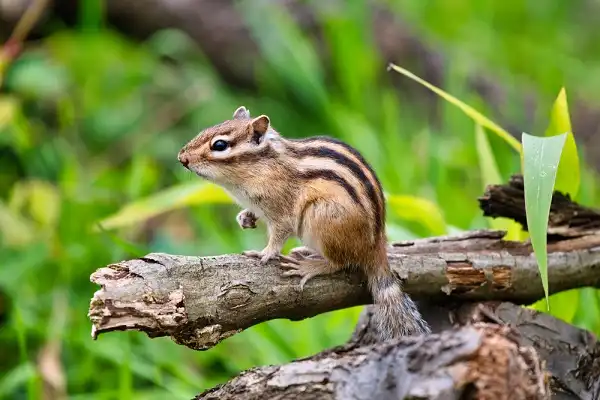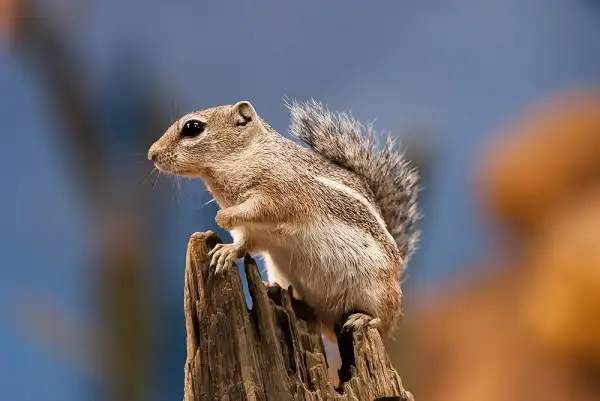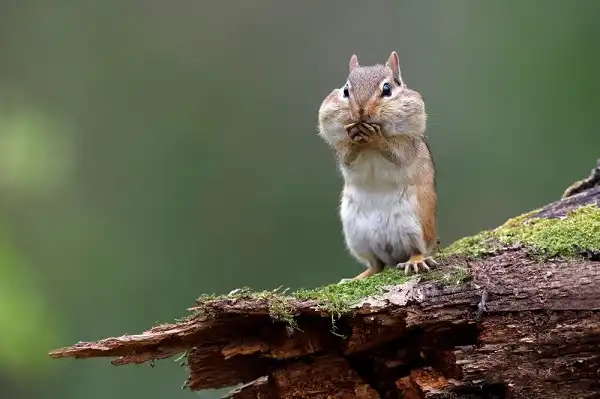Meet the chipmunk: a small, quick-moving rodent with distinctive stripes on its back and sides. These little creatures are found all over North America, and while they might seem cute and harmless, they can actually cause quite a bit of damage to your property. Read on to learn more about these pests and how to keep them away from your home.

Chipmunk Description
Chipmunks are small, furry creatures with reddish-brown fur, a white underside, and two dark stripes running along the back, with slender bodies and short legs. Chipmunks have large ears and eyes that allow them to locate food quickly. Their front paws have sharp claws that they use for digging as well as climbing, which helps them find food in hard-to-reach places.
Chipmunk Habitat
Chipmunks are native to North America and can be found in a variety of different habitats such as forests, meadows, grasslands, and even near urban areas. They prefer open or semi-open spaces with plenty of vegetation where they can find food sources and build their burrows. Chipmunks typically construct their dens using leaves and twigs in shallow holes or cracks in rocks or logs. Chipmunks are most active during the day when they search for food and build nests; however, they will also come out at night if the temperature is right. During cooler weather chipmunks will hunker down in their burrows to conserve energy until conditions become more favorable. They will also hide inside their dens during periods of heavy rain or snowfall so that they don’t get soaked while trying to look for food.
In order to survive cold winter temperatures chipmunks enter into a state of hibernation known as torpor where their body temperature drops drastically allowing them to conserve energy until spring arrives again. During this time period, chipmunks may wake up occasionally for brief periods in order to eat any stored foods before returning back into hibernation until it warms up again outside. Due to their adaptability and resourcefulness chipmunks have become quite common throughout North America and can often be spotted scurrying through fields or forests searching for food or building nests inside hollow logs or fallen trees. Despite being considered pests in some areas they are still beloved by many due to their cute appearance and playful nature as well as the role they play in local ecosystems by dispersing seeds that help promote plant growth throughout the environment.
Chipmunk Diet
Chipmunks are omnivores, meaning that their diet consists of both plant and animal material. A chipmunk’s natural diet consists primarily of seeds, nuts, fruits, insects, small vertebrates like lizards or mice, and carrion. Chipmunks will also feed on human garbage and pet food when available, taking advantage of the abundance of food sources in urban environments. To supplement their diets they will also store food in their burrows to help them survive the winter season when food is scarce. Chipmunks have large cheek pouches which they use to carry seeds and other items back to their dens for storage. This allows them to gather up large amounts of food quickly before retreating back into the safety of their burrows. They will also take advantage of bird feeders and other easy-access sources available in residential areas to supplement their diets with additional protein-rich foods such as mealworms, corn, or sunflower seeds. Chipmunks are opportunistic eaters and can quickly adapt to changes in their environment by eating whatever is most readily available at any given time. They tend to prefer sweet things such as berries but will also consume fungi, leaves, roots, buds, bark, and grasses if necessary. In addition, they may supplement their diets with small vertebrates like mice or lizards which they catch using quick reflexes and a sharp set of claws and teeth!
Chipmunk Size
Chipmunks vary in size depending on the species, with the smallest species being as small as three inches long and weighing around one ounce. On average, chipmunks are four to six inches in length, excluding their tail which can add another two to five inches. They typically weigh between two and four ounces but the largest species can reach up to nine inches in length and weigh up to nine ounces. Overall, chipmunks are small but mighty rodents that have adapted perfectly to the often harsh North American environment they inhabit.

Chipmunk Lifespan
Chipmunks typically have a lifespan of around 3 to 5 years in the wild, though some individuals may live for up to 9 years. However, in captivity chipmunks can survive for much longer due to controlled environments and access to food and water year-round. The oldest recorded chipmunk in captivity was over 20 years old! Chipmunks reach adulthood relatively quickly, usually at 6 months of age, but they may take up to 2 full years before they are able to reproduce successfully. They have an average litter size of 4 or 5 pups which are born blind and deaf but they mature quickly and often leave their mother’s side after only a few weeks of life. In addition to natural predators such as hawks and owls, domestic cats also pose great threats to young chipmunks as cats are known for preying on small rodents that come too close. Domestic dogs rarely pose a threat however as chipmunks will scurry away at any sign of danger from a distance well beyond what most house pets can travel!
Chipmunk Behavior
Chipmunks are mainly diurnal animals, meaning they are most active during the day. They typically spend their mornings foraging and eating before taking a break in the afternoon to find a safe place to rest. At night they sleep in burrows or other sheltered spots that provide them with protection from predators and extreme temperatures. Chipmunks have both territorial and social behaviors, meaning they can be solitary animals or form small groups that often interact with each other. When living alone, chipmunks defend their territories against intruders by emitting loud alarm calls, chasing them away, or facing them down with a warning posture. If one chipmunk runs into another from a different group, however, it will usually greet it with friendly gestures such as grooming and soft chirping. When competing for food, chipmunks employ several clever strategies such as hoarding nuts in caches around their territory or even swiping morsels from other animals! They are also known to use tools such as sticks or stones to retrieve hard-to-reach items like insects hiding in crevices; thus proving their remarkable intelligence! Furthermore, chipmunks gather in communal areas called “scatter hoards” where they collect acorns and seeds en masse before carefully packing and storing them away for later consumption when food is scarce.

Chipmunk Speed
Chipmunks are known to be one of the fastest animals among their peers, with the ability to reach speeds of up to 12 miles per hour when running. They are also incredibly agile, able to make quick and precise turns while sprinting in order to avoid obstacles or predators. Chipmunks possess short but powerful legs that allow them to climb and move quickly through trees and other vegetation while they hunt for food. They can leap between branches or scramble across open ground with great agility, making them difficult targets for predators. In addition to their speed, chipmunks have strong claws that help them grip surfaces and better navigate their way through the terrain. In addition to their impressive agility, chipmunks possess a special form of locomotion called “galloping” which is used when confronted with danger or chasing after prey. During this type of movement, the chipmunk will alternate its legs in a bounding motion as it runs at an even faster rate than usual. This technique allows the animal to cover large distances quickly and safely over open land or slippery surfaces like ice or snow.
Chipmunk Hunting
Chipmunks have evolved several hunting strategies to survive in their environments. One of the most common is foraging, which involves searching for food in a variety of places such as under logs, in trees, and even in human dwellings. Chipmunks use their keen eyesight and sense of smell to detect food sources, though they tend to rely more heavily on sight compared to other animals. Another tactic employed by chipmunks is stalking. This involves patiently waiting near potential prey until it is within striking distance before quickly pouncing on it with lightning speed. They typically hunt small insects, amphibians, and reptiles such as frogs or lizards; however, they will also occasionally consume larger prey like birds or even small mammals like mice! A third method of hunting chipmunks use is ambushing. This involves concealing themselves among vegetation or in burrows and then springing out at passing prey suddenly when the opportunity arises. They are also known to follow animal trails and set up ambushes along these pathways as well; often waiting for hours before finally snatching up unsuspecting victims! Chipmunks are also highly capable climbers, making them adept hunters in trees as well as on the ground. They use their sharp claws to cling onto bark and limbs while scanning the area for potential meals; often leaping from one tree to another with ease in pursuit of a snack!

Conclusion
Chipmunks are incredibly agile, adaptive animals with a variety of strategies to ensure their survival. Their remarkable speed and keen eyesight give them the ability to navigate through dense vegetation or open terrain with ease and quickly evade potential threats. Furthermore, their strong claws make it possible for them to climb trees and hunt from above as well as on the ground – all-important adaptations that help keep them safe from harm! With such impressive abilities, it’s no wonder why chipmunks have managed to survive in a wide range of habitats!
Frequently Asked Question

